Welcome to Creator Columns, where we bring expert HubSpot Creator voices to the Blogs that inspire and help you grow better.
In the 5 years I’ve run Nudge, I’ve interviewed dozens of experts on pricing. These aren’t run-of-the-mill LinkedIn gurus. They’re peer-reviewed researchers from some of the world’s most prestigious universities. In this blog, I reveal their top five pricing tips.
5 Secrets About Pricing
Recently on my podcast Nudge, a guest told me a secret about pricing.
“The truth,” Melina Palmer said, “is that pricing isn’t really about the price.” Instead, it’s everything around the price. The framing, the offer, the brand. That’s what makes people buy.
This insight has been backed up by dozens of other behavioural scientists who I’ve interviewed for my show, and in hundreds of peer-reviewed papers I’ve read on the topic.
Simply put, offering a lower price isn’t the smartest way to improve your sales. Instead there are five other tips I’d suggest you try first.
1. Break your price down.
When showing your price, try to break it down into smaller increments.
Richard Shotton, in his book the Choice Factory, ran tests with customers looking to purchase a car. Some potential buyers saw the cost outright ($40,000). Some saw the cost per day over the course of several years ($11 a day).
Those who saw the price broken down were 4x more likely to rate the price as a good deal and 50% more likely to buy.
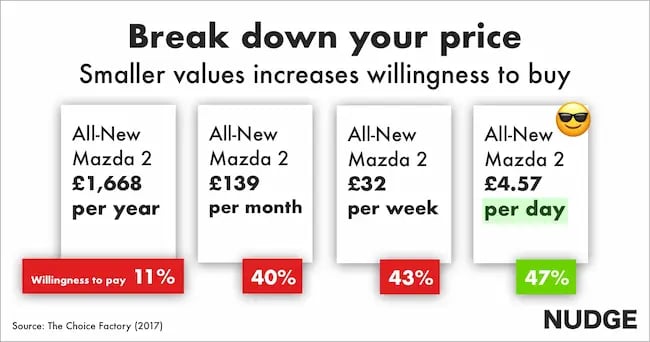
This doesn’t only work for expensive products like cars.
John Gourville in 2003 published a paper that found that cheaper items — like mobile phone contracts — were seen as more affordable when framed in daily terms. The contract was seen as better value when shown as $1 per day — rather than $30 a month.
So, when setting your price, consider showing the price per day equivalent to customers.
2. Avoid round numbers.
When setting the price, don’t opt for a round number.
Michael Santos, a psychologist at the University of California, demonstrated why in his 1994 study. For the study, the researchers dressed up as street beggars and requested donations from pedestrians.
Some asked for rounded amounts, like a dollar or a quarter. Others asked for precise amounts like $1.02 or 35 cents.
Incredibly, those that asked for the specific amounts received 60% more donations. 60% more, even when they asked for more than the rounded amount. Asking for 35 cents gets more donations than simply asking for a quarter.
The specificity makes the request seem more genuine — encouraging people to donate more.
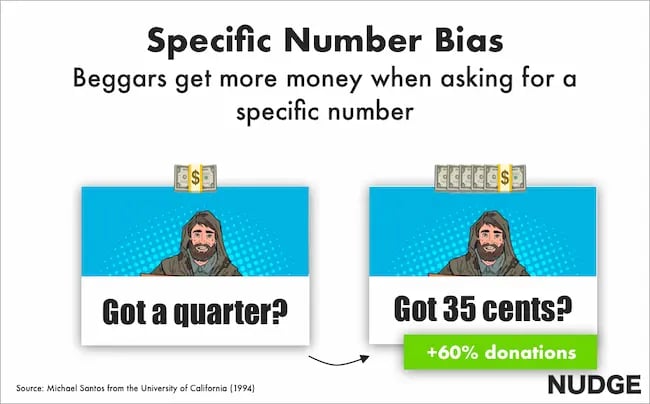
This has real world implications.
A 2008 study of 25,000 house sales in Florida found that homes that listed their sale price as a specific price sold for closer to their asking price.
For example, listing a house at $249,749 — rather than a rounded price of $250,000 — would increase the end-sale price.
Being precise increases the appeal of your price. So ditch rounded prices.
3. Add a premium decoy.
If you want to increase your sales, you should create a premium option that you don’t expect customers to buy. It sounds irrational — but it works.
It’s known as decoy pricing.
Dan Ariely, in his book Predictably Irrational, showed how The Economist Magazine used this so effectively in the early 2000s.
Originally, The Economist offered two subscriptions.
- Web-only subscription for $59
- Print & web subscription for $125
Later, they added a decoy option. A print-only subscription that costs as much as the print & web subscription.
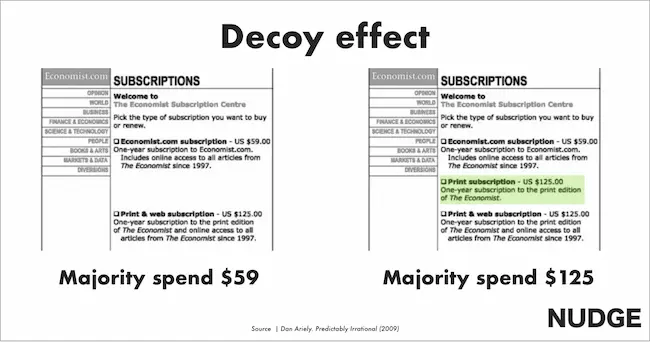
Adding the decoy changed consumer behavior. Previously, the majority bought the $59 web-only subscription. But after seeing the decoy price, the majority picked the $125 print and web subscription.
Adding an expensive premium decoy makes your standard option seem more appealing. It anchors the buyer to a higher price point and makes the original offer look better value.
Researchers in 2018 found the effect still holds true today. Experiments at the National Academies Press showed that introducing a hardcover priced between 160% and 790% more expensive than the paperback increased paperback sales by 16.2%.
So if possible, introduce a higher-priced decoy into your pricing mix.
4. Enforce a purchase limit.
Enforcing a purchase limit sounds a little irrational. Surely to increase sales you shouldn’t cap how much a customer can buy?
But some smart marketers would disagree.
One study from the 2011 Journal of Marketing Research looked at soup sales at American grocery stores. Half the stores showed advertising banners encouraging customers to buy soup — these were standard adverts that read:
“Buy soup today”
The other stores had the same adverts, but with one twist — a disclaimer next to the ad which said:
“Buy soup today: limited to 12 cans of soup per customer.”
Nobody was buying 12 cans of soup in the first place, so you might think this message is fairly pointless, but it wasn’t.
The limitation made the product seem scarce — and it increased sales by 112%.
Capping how much a customer can purchase can increase sales — so consider adding some limits to your product availability.
5. Don’t say “it’s free.”
Often, to increase the appeal of a price, marketers throw in a bonus product “for free.” We assume this will work well. After all, who doesn’t like free stuff? But it’s not the smartest way to promote your product.
This insight comes from a 2020 study by two Korean researchers Koo and Suk. They ran online experiments in the US, UK, Canada and South Korea. Hundreds of participants would see two different types of promotions.
Some would see that the bonus product or service was “free.”
Other times the promotion would state it’s $0.”
Saying it’s $0 appears to work best. In the 10 experiments, saying $0 was more effective as a promotion than saying it’s free.
Why? Well, $0 seems a bit more salient, it stands out. It’s a simple, yet effective way to improve any promotion.
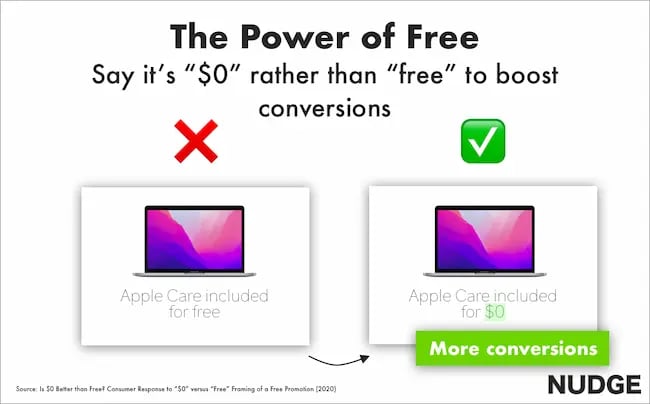
To create a great price you need to think beyond the number. Offering the cheapest option won’t always win. And often, adding some psychology to your price can be better than trimming the cost.
This blog is part of Phill Agnew’s Marketing Cheat Sheet series where he reveals the scientifically proven tips to help you improve your marketing. To learn more, listen to his podcast Nudge, a proud member of the HubSpot Podcast Network.




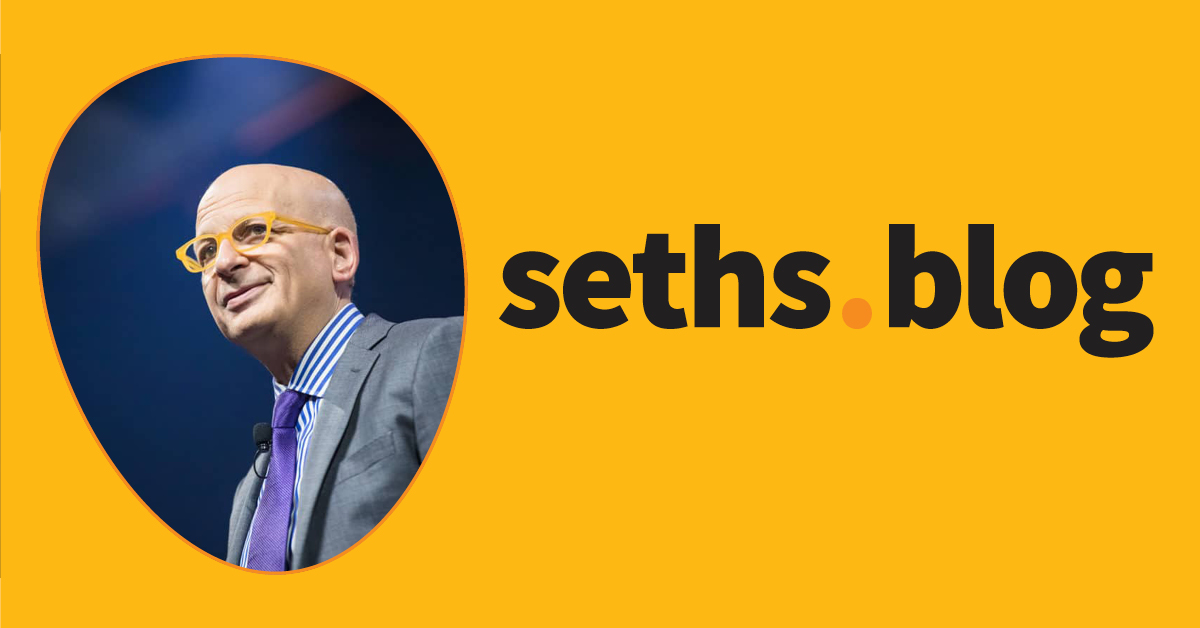
![How to Optimize for Google’s Featured Snippets [Updated for 2024]](https://moz.com/images/blog/Blog-OG-images/How-to-Optimize-for-Googles-Featured-Snippets-OG-Image.png?w=1200&h=630&q=82&auto=format&fit=crop&dm=1724004002&s=13df73104762982790dab6dc8328023f)


